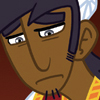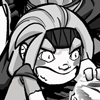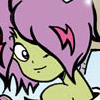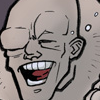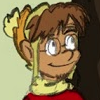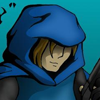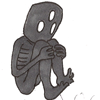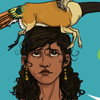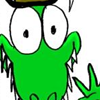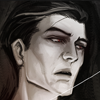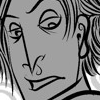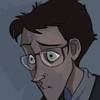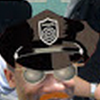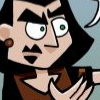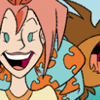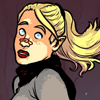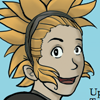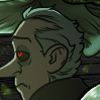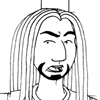Category Archives: sci-fi webcomic
Robots, Evolution, and the Future of the Human Race: What Webcomics Have to Say About Transhumanism
 There was a time I thought listening to talk radio was for old people. I do a lot of carpools, and typically someone will have the radio turned to either the news or boring old NPR. This would annoy me tremendously. Why are you listening to someone drone on when you could be blasting some Major Lazer, dude?
There was a time I thought listening to talk radio was for old people. I do a lot of carpools, and typically someone will have the radio turned to either the news or boring old NPR. This would annoy me tremendously. Why are you listening to someone drone on when you could be blasting some Major Lazer, dude?
Perhaps it’s a sign of my age, or perhaps it is my diminishing tolerance for tunes that have lyrics in them, but I found that I’ve been listening to a lot of talk radio myself lately. Only, not in the form of actual radio waves captured by the car antenna. I’m talking podcasts. Whether it’s the McElroy Boys playing Dungeons & Dragons in The Adventure Zone or Dan, Elliott, and Stuart jawing about movies on The Flophouse Podcast, my days are spent with people I can pretend are my much smarter imaginary friends having scintillating conversations. Is that the true appeal of talk radio?
One such podcast, Stuff They Don’t Want You To Know, recently veered off into a topic I hadn’t expected. I tune into a podcast with that name for paranoid conspiracy theories, dammit! Instead, the hosts began speculating about transhumanism. It’s a topic that seems to have been brewing in the background of several previous shows. One episode talked about how technology has basically given us psychic powers: what is social media, after all, but a form of telepathy, where your privy to the innermost thoughts of your friends online? Shoot, you out there on the internet somehow know all my thoughts about webcomics at this very moment! The acceleration of technology has connected us closer than ever before, to the point where online marketers know exactly what they need to sell to you with only a few points of data.
Which brings us to transhumanism, i.e. the theory that the human race can evolve beyond its current physical and mental limitations. One podcast episode began discussing, at length, about the potential for space travel. As you do. The consensus with the hosts was that any form of travel beyond our solar system was physically impossible. However, one host began talking about what composes the human body. We are just a bunch of tiny living organisms — cells — that come together to form a thinking, living being. Our tiny cells probably go about their day, eating and reproducing, without any notion that they are part of a larger organism.
Nothing new, incidentally. I had to read a book in high school, The Lives of a Cell, that makes the same observations, and it was first published in 1974. Being a small organism caught up in the collected consciousness of a larger creation was a part of 1969’s Galactic Pot Healer as well (written by sci-fi legend, Philip K. Dick).
So here’s the big question: what if we’re not the final stage in evolution? What if, as the host coined, we’re just the midwife to an organism that can, in fact, traverse the stars? And what if that organism is the collective intelligence of all humanity, bringing things to the next level that we tiny cells will never see? The Lives of a Cell theorized that the bigger organism would be the planet itself… but a planet isn’t mobile. What if that organism is a robot, one that can travel the stars and move beyond our fleshy confines? Should we be terrified? Or should we rejoice?
WCO#239: Dresden Codak

Aaron Diaz’s Dresden Codak is a strange creature. It debuted back in 2005, back when webcomics were developing a reputation as the sophisticated alternative to their comic strip brethren. xkcd launched in the same year, and A Lesson Is Learned But The Damage Is Irreversible not long before that. Perry Bible Fellowship was starting to gain a strong following. At the core of these comics as a brainy just-out-of-college mentality. The gags were still sometimes juvenile, but at its core were concepts and ideas that were smarter and more clever than ones on the Sunday Funnies. Except Marmaduke. That comic is pretty dang subversive.
And all of them, including xkcd sometimes, would surprise you by hitting you with some great looking art. It may be easy to forget, since a lot of art grads now know of webcomics as a great way to expand their portfolio, but aesthetically webcomic art was pretty dire. The medium, after all, was originally conceived as an amateur hobby where some folks got lucky despite the artistic merit, e.g. tons of pixel comics. As a result, comics like Dresden Codak were incredibly eye-catching in comparison.
Typical of early Dresden Codak is a comic like “Li’l Werner.” It’s a one-shot comic with no continuity baggage. Diaz is still experimenting with his art style: this time homaging the black-and-white cross-hatching of Edward Gorey. The strip hinges around a tongue-in-check parody of Aryan physics (the Nazi nationalist scientific movement to discredit Jewish scientists like Albert Einstein). There’s a sharped-toothed Philip Lenard recalling anti-Semitic caricatures, a tiny Heisenberg, and something about “current momentum.” I don’t pretend to know what the heck any of this is about. But it sounds smart and the multiple tiny Heisenbergs is a cute visual gag. It’s a lovely comic to introduce to your local Tesla fan.

WCO #238: LARP Trek

The great songwriter “Weird Al” Yankovic once wrote, “The only question I ever though was hard was ‘Do I like Kirk or do I like Picard?'” Also he wrote that he memorized Monty Python & The Holy Grail, and his quote were sure to have you rolling on the floor, laughing.
But back to Star Trek. It’s a heady question. One that has likely ruined friendships and spurred a pointless internet discussion or two. Kirk appeals to renegade adventurer types who crave action and diplomacy solved by bare chests and balled-up fists. Picard appeals to those who love class, civility, and French captains who inexplicably talk with a British accent. (Actually, there is a somewhat canon explanation for that last part… but it is beyond stupid and does not bear repeating.)
Webcomic creators seem to fall firmly in the Picard camp. There are parodies. Videos. Erotic adventures. Plus he’s Patrick Stewart, whose dulcet tones are far more seductive than William Shatner’s hamminess. Thus, the fondness for the OG baldheaded captain should come as no surprise. Many webcomic creators are in their 30’s and 40’s, and when they were kids The Next Generation was the jam. Maybe in a decade or so, there’s going to be a ton of Star Trek Enterprise references in webcomics… but don’t hold your breath on that one.
Ah, but what of the great Deep Space Nine? While not quite the pop culture juggernaut as the original series or the Next Generation, DS9 is nevertheless regarded by many Trek fans as the best Trek series. Well, Josh Millard didn’t forget, and DS9 features prominently in his webcomic LARP Trek.
WCO #231: MS Paint Adventures: Homestuck (Act 5)
(This is Part 2 of the massive Homestuck review. Click here for Part 1, covering Acts 1-4.)
I get it.
I totally get it. The appeal of the trolls, I mean.
When Andrew Hussie’s MS Paint Adventures: Homestuck started out, the characters could be best described as perhaps being tied to one personality trait. John is nerdy, Rose is gothy, Dave is cool, and Jade is sunny. They’re pleasant enough protagonists, but they’re pretty much video game heroes. Whether you’re Master Chief, the marine from Doom, Mario, Sonic, or the guy from BioShock, the main character is typically a stand-in for the player (or in this case, the reader). There has to be enough wiggle room for you to, in a way, become that character.
The trolls are different. I have a weird feeling that when Hussie started off Chapter 5, he was intentionally trying to tax the reader’s patience. We’ve been following the same four characters for four whole acts, when all of the sudden they disappear and are replaced by twelve all new characters that we hadn’t been invested in at all. Now, as an avid reader of fantasy novels, I’m pretty used to chapters where we abandon our main characters for long stretches to flesh out and establish new characters and communities. I have a feeling, though, that when this act came out, long time readers were throwing their hands up in disgust but about, say, the fifth troll introduction.
Yet, at the same time, the trolls ended up becoming the most visible symbol of Homestuck. I remember distinctly when the initial supporters (usually posting some variation of “Wake up, boy”) gave way to the cavalcade of troll fan art and cosplayers. I’d read some Homestuck before, though I’d stopped before even the end of Act 1. And I remember scratching my head, thinking, “Wait. This is the same webcomic?”
All the same, I totally get it.

(NOTE: The following review will compare Homestuck to friggin’ James Joyce and George Bernard Shaw. For readers with low tolerance for pompous malarkey, discretion is advised. Then again, PBS and Tor Books’ Mordecai Knode made the same comparison, so nyeh!)
The Webcomic Overlook #231: MS Paint Adventures: Homestuck (Acts 1-4)

I’m baaacccckkkk!
It’s time once again to delve into the world of comics in the digital medium, where your eyes are bombarded not by inks and tree fibers but rather by the warm, embracing glow of an LCD monitor. There’s been a pretty big gap in my reviewing back catalogue, which for some reason includes something called Loviathan and something called Glam but for some reason doesn’t include the webcomic whose cosplayers overtook Emerald City Comic Con this year.
That’s right, readers: it’s time for yet another review of Andrew Hussie’s MS Paint Adventures: Homestuck!
Now, for those of you who are unfamiliar with Homestuck, or maybe you’ve heard about it in bits and pieces but really don’t know much about it, there’s one thing you should know right off the bat: it’s a very long webcomic. A VERY long webcomic. And deceptively so. As a result, I’m splitting this review into two segments. The first will reivew Acts 1-4, which focused mainly on the players of John, Rose, Dave, and Jade. (I will call these four “Pesterchums.” I don’t know if that’s the official term for them, but that’s how they appear categorized in their chatlogs.) The second will deal with Acts 5 and beyond, which seems to focus on the trolls.
Is this a fair dividing point? I think so. Back in the day (holy crap, this comic started back in 2009?) fans on the webcomic seemed to be split on how to take Act 5. The focus one trolls cause some to quit. On the other hand, trolls seems to be what maneuvered Homestuck to the big leagues. How much fan art is devoted to trolls vs. that which is devoted to the original crew? I’m guessing a million to one. As a result, my scholarlycomparison of trollspeak to Li’l Abner‘s cornpone dialects is going to have to wait until Part 2. Doesn’t that sound exciting?
… yeah, I didn’t think so either.
Random Quickies: Super Mario Bros. 2: The Comic
Nintendo video game mascot Mario Mario is no stranger to webcomics. Thanks to the crazy video game webcomic boom that gave the world the PAX video game convention, Mario has probably appeared in more webcomics than video games. Shoot, there’s probably a webcomic out there referencing Mario being created as we speak. However, there’s one aspect of the Mario universe that doesn’t get touched upon that often. You know, the one where King Koopa was evolved from dinosaurs and played by a greasy Dennis Hopper? The one where Mario and Luigi were trying to liberate a dystopian cyberpunk alternate dimension, clearly an aspect of the Mario universe that needs to be expanded upon and explored?
Why do webcomic creators always seem to cruelly ignore Mario and Luigi from the 1993 Super Mario Brothers movie?
Steven Applebaum and Ryan Hoss must be some sort of genies, because they’re making all your dreams come true with Super Mario Bros. 2: The Comic. SMB2: The Comic answers the question that has, for 20 years, been lingering on all our minds after the tantalizing sequel bait at the end of the movie: what happens to the Mario brothers after Princess Daisy returns from an alternate dimension, armed to the gills like some 90’s Image Comics superhero? This ain’t no video game run of the mill fanfic, people, as it’s mentioned that the story ideas come straight from one of the ten screenwriters from the movie. So it’s at least … one-tenthed canon, maybe?
Anyway, it involves going to another dimension which is probably the same world as the one from SMB2: the video game. And like the game, odds are Mario is going to wake up from a particularly vivid fever dream where someone, somewhere, made a webcomic sequel to the Super Mario Brothers movie.
(h/T AV Club)
The Webcomic Overlook #230: Ava’s Demon

It’s getting to be a familiar site these days to see animators flexing their creative juices in webcomics. Just about 5 years ago, it seemed like a novelty when Chris Sanders, animation director of Disney’s Lilo & Stitch, brought his verve to the little electrical screen with Kiskaloo. An actual animator! Deigning to illustrate webcomic! How about that! Man, webcomics aren’t just for bored college liberal art students with a poor grasp of MSPaint anymore!
Nowadays, it’s a little more commonplace. Katie Rice, the winner of this year’s Strip Search, to point out one of the most prominent examples, is herself an animator. I suppose it makes sense. As an animator, I’m thinking that most of the time you’re shackled to someone else’s brilliant vision… like, say, Madagascar 3: Europe’s Most Wanted. Sure, there’s some creative leeway there. Maybe suggestions on the character design. Or ideas on fun little background elements. Or animating the letters “S-E-X” in the clouds near Aladdin and Jasmine.
I, too, wanted to be an animator once. Inspired by the Disney Renaissance of the early 90’s, I even once bought a book about how to break into the biz. If these animators were anything like I was, I’m guessing a lot got into the field because they wanted to tell stories. Their stories. There’s a creative force gnawing inside, waiting for the day when it can be finally unleashed on the world. Something like … a crazed little demon.
Speaking of crazed little demons, that’s sort of the premise for Ava’s Demon. The webcomic was created by Michelle Czajkowski, who, as I understand it, is an animator at Dreamworks.
The Webcomic Overlook #229: Hoop Fighter

A couple weeks ago a buddy and I were watching Game 6 of the Miami Heat/Indiana Pacers game. Guys like Chris Bosh and LeBron James were flopping to the ground to get the referees to call the fouls, our discussions turned to our favorite teams. My buddy was a big fan of the Heat. (He was pretty much the only one in the bar rooting for them. Everyone else was pulling for the Pacers to upset.) Me, though, I had to vouch for the team nearest and dearest to my heart: the Detroit Pistons.
And when you’re talking about the Pistons, inevitably the discussion turns to the legendarily thuggish team of the late 80’s-early 90’s called The Bad Boys. Dennis Rodman. Isiah Thomas. Bill Laimbeer. Vinnie “The Microwave” Johnson. Joe Dumars. “Man, I miss those days,” I said, pointing to the players as they gingerly hit the ground after every foul. “Back then, not only would they have taken the elbow to the stomach, they would’ve come back at you and returned the pain tenfold.”
(Ah, the glory of being a Pistons fan. Even when they’ve won the championship as recently as 2004, you never forget your first love that is The Bad Boys.)
Am I naive to dream of earlier, more brutal time? Maybe. But maybe it’s also… the future! At least, that’s how it looks in Scott Sava and Alex Kolesar’s basketball themed webcomic, Hoop Fighter.















